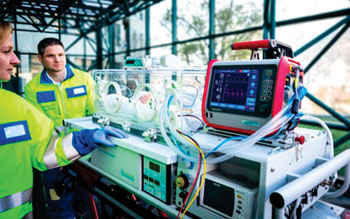Novel Transport Ventilator Now with Neonatal Option
By HospiMedica International staff writers
Posted on 22 Sep 2014
A transport ventilator offers the same capabilities found in full featured neonatal intensive care unit (nICU) ventilators, but in a mobile format.Posted on 22 Sep 2014
The HAMILTON-T1 transport ventilator with neonatal option has been specially adapted to meet the needs of ventilated neonates. Supporting tidal volumes of just 2 mL, the HAMILTON-T1 allows for effective, safe, and lung- protective ventilation, thanks to a reliable and robust flow sensor that accurately measures pressure, volume, and flow proximal to the patient. This guarantees the required sensitivity and response time and prevents dead space ventilation, resulting in a patient that is better synchronized, with reduced work of breathing (WOB).

Image: The HAMILTON-T1 transport ventilator with neonatal option (Photo courtesy of Hamilton Medical).
The new neonatal expiratory valve can balance the smallest differences in pressure, offering the neonate to breathe spontaneously in each phase of a controlled breathing cycle. In addition to standard ventilation modes, the HAMILTON-T1 offers a new neonatal continuous positive airway pressure (nCPAP) pressure control (PC) mode, which defines the desired CPAP target value. The ventilator then automatically and continuously adapts the required flow to the patient's condition, reducing WOB, reducing the need for user interventions, and ensuring optimal leak compensation.
A built-in high-performance turbine makes it completely independent of compressed air, gas cylinders, or compressors (if needed), saving weight and space, and allowing even noninvasively ventilated neonates to be transported over long distances. The built-in battery provides operation for more than nine hours, which can be extended indefinitely with hot-swappable batteries. The HAMILTON-T1 transport ventilator is a product of Hamilton Medical (Bonaduz, Switzerland), and has received the European Community CE marking of approval.
The HAMILTON-T1 was designed to cover the needs of rescue personnel, health care teams, and comes with a choice of sturdy mounting solutions to fit a broad variety of needs, integrated solutions for mechanical mounts, worldwide electrical supplies, multiple gas supplies, and on airway carbon dioxide (CO2) monitoring. The International Design Excellence Award (IDEA) competition, organized by the Industrial Designers Society of America (IDSA; Herndon, VA, USA), awarded the HAMILTON-T1 a Bronze medal in 2012 and Silver medal in 2014.
Related Links:
Hamilton Medical
Industrial Designers Society of America














